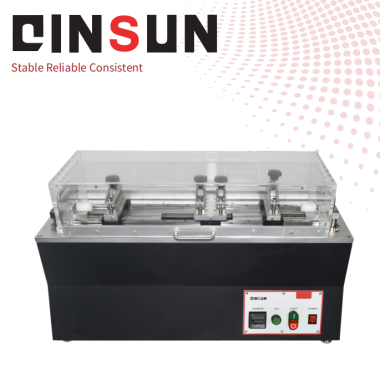Tiempo: Popularidad:0tiempos
Used to evaluate the fatigue resistance of seams in automotive seat surface materials. Most automotive seat surface materials (genuine leather, synthetic leather, fabric, etc.) are spliced and stitched together. The seam strength and fatigue resistance of these seams directly impact the seat's service life.
The leather seam fatigue tester is used to test the fatigue resistance of seams. Under specified test conditions, a seamed specimen is placed in the machine and repeatedly subjected to tension-relaxation cycles at a fixed frequency. After a certain number of cycles, the specimen remains in the tester and, while the original load is maintained, the size of the seam stitch hole is measured. This represents the fatigue resistance of the seam.
Specimens are 10 cm wide and 10 cm long. Two specimens are collected in each of the warp and weft directions, forming a group. Prepare two groups. Two specimens are overlapped and, starting 10mm from one side, sewn using a sewing machine to create a test piece with a seam spacing of 20 ± 2 stitches/100mm. The piece is then mounted on the left and right clamps of the testing machine and subjected to 2500 reciprocating cycles at a load of 29.4N (3kg) and a speed of 30 reciprocating minutes. After the test, the fatigue strength of the seam is evaluated by measuring the size of small holes caused by slippage and other factors in the seam of the specimen under load.
The operator installs a height setting gauge between the pair of sample clamps at the test station. Align the sewn sample and clamp it in the desired position, then remove the height gauge. The operator then sets up a second test station, aligns the second sample and clamps it in the desired position, removes the height gauge, enters the number of test cycles into the counter, and begins the test. The machine automatically stops once the set test cycle is reached, and the test sample is visually evaluated.
Clean the clamps regularly to prevent residue from affecting the clamping force. Check fixture wear: Replace severely worn fixtures promptly.
Equipment Maintenance: Ensure equipment is in good working condition, especially by regularly inspecting and replacing key components such as fixtures and sensors.
Sample Preparation: Ensure the seams of the leather products being tested are in good condition, free of obvious flaws or damage.
Data Analysis: Conduct in-depth analysis and interpretation of test data to identify potential quality issues and propose improvement measures.

Teléfono de la empresa
+86-21-6420 0566
Horas de trabajo
De lunes a viernes
Teléfono móvil:
13816217984
Correo electrónico:
info@qinsun-lab.com
